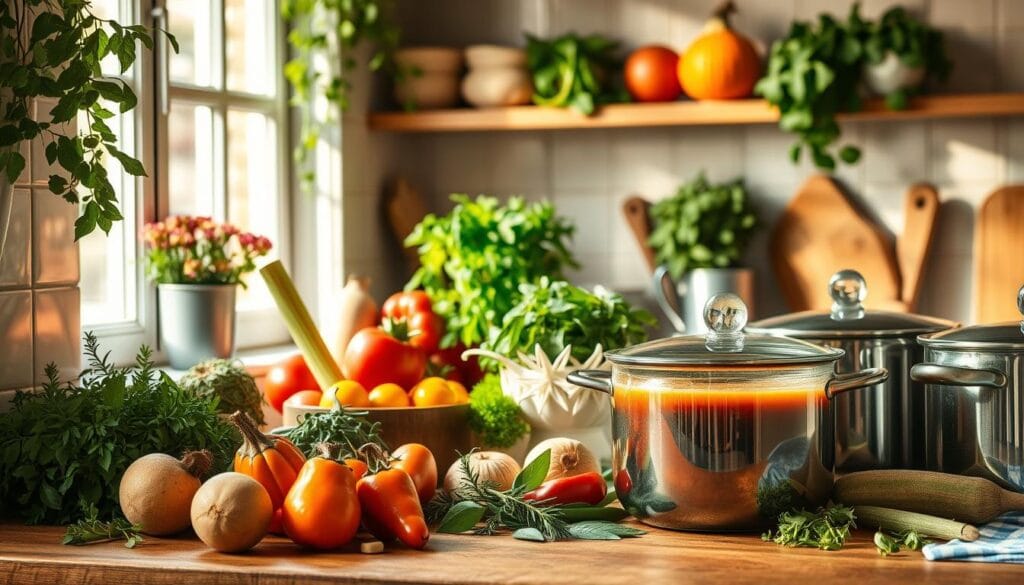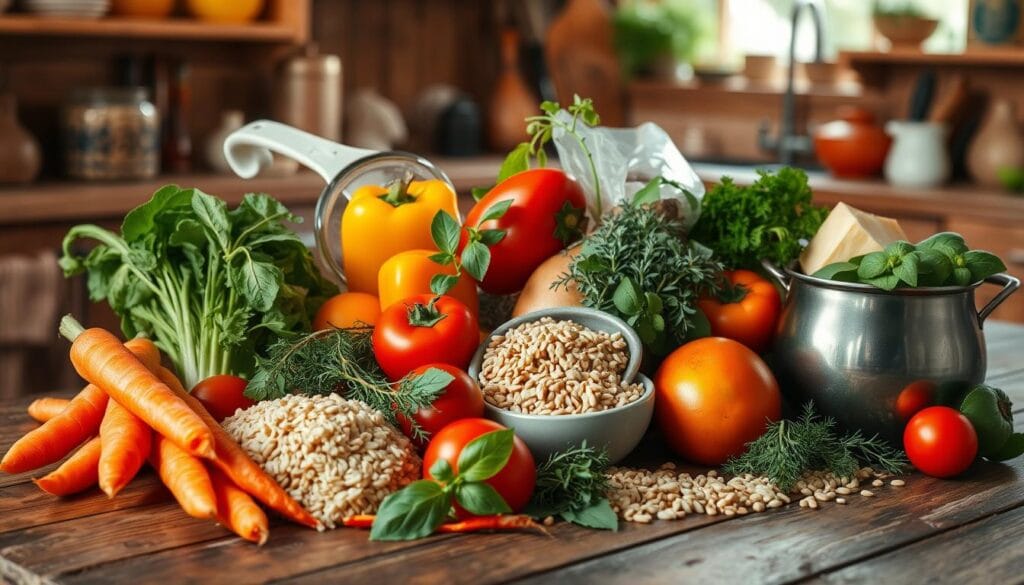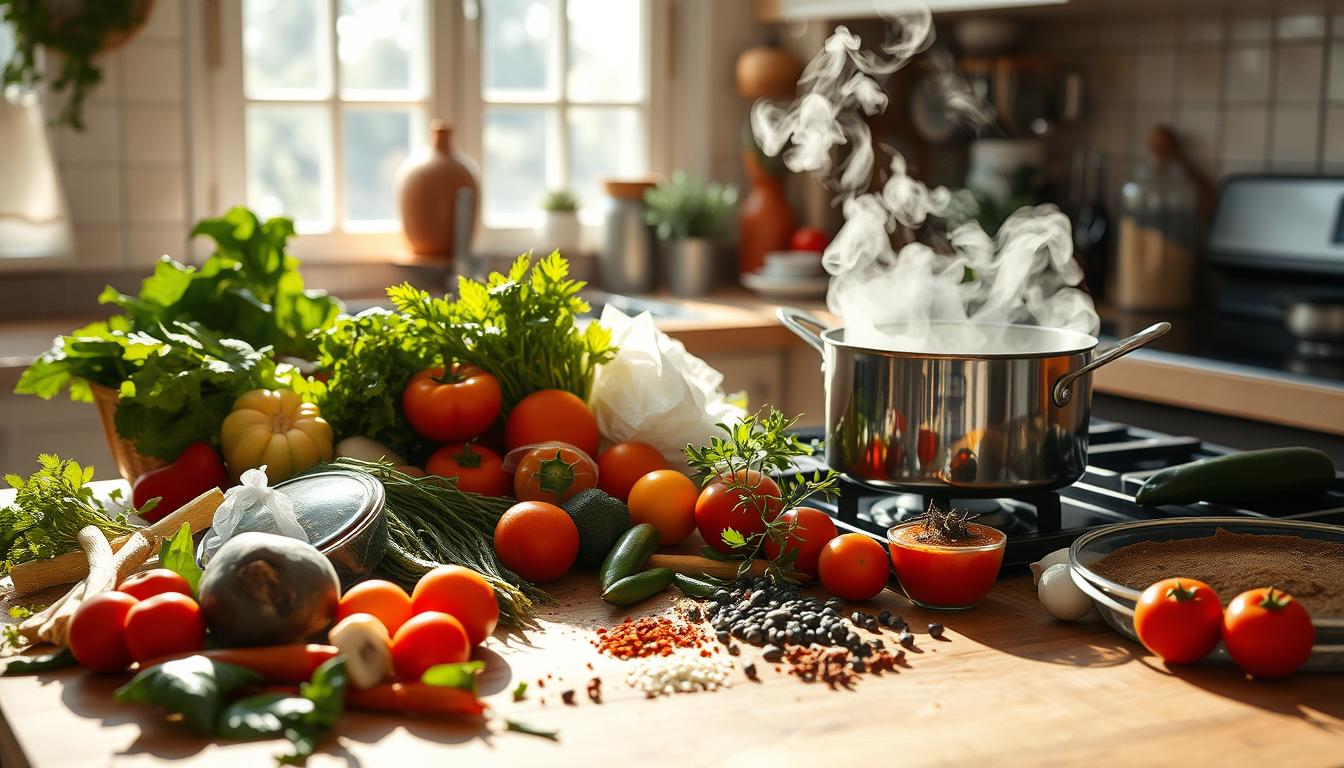Soup Recipes Abiotic Factor in Cooking
The secret of success is to know something nobody else knows. – Aristotle
In the world of cooking, making delicious soups is an art. But there’s a science behind it that many overlook: abiotic factors. These include things like temperature, humidity, and water quality. They greatly affect how our soups turn out.
This article will explore the connection between cooking science and soup-making art. It aims to help you improve your soup recipe abiotic factor.
Table of Contents
Key Takeaways
- Abiotic factors, such as temperature and water quality, significantly impact the cooking process of soup recipes.
- Understanding the science behind these environmental elements can help you create more flavorful and consistent soup dishes.
- Adjusting factors like cooking time and pH levels can enhance the overall taste and texture of your soups.
- Certain soup recipes’ abiotic factors are better suited to handle specific abiotic factors, making them more beneficial or harmful depending on the conditions.
- Proper cooking techniques and equipment can help mitigate the negative effects of abiotic factors and optimize the results of your soup recipes.
Introduction to Abiotic Factors in Cooking
Creating tasty soup recipes abiotic factor depends on knowing about abiotic factors. These are non-living parts of our environment like temperature, water, air, soil, and sunlight. In cooking, they are the physical and chemical conditions that shape our recipes, especially soups.
Definition of Abiotic Factors
Abiotic factors are the non-living parts of our environment that affect living things. In the kitchen, they include things like temperature, water quality, and pH levels. These factors play a big role in how we cook.
Importance of Abiotic Factors in Cooking
Abiotic factors are crucial in cooking. They control how fast chemical reactions happen, the texture of food, and the taste. Knowing how to use these factors can make your soups taste amazing every time.

The way abiotic factors work in the kitchen is really interesting. It can greatly affect how we make soups. In the next parts, we’ll look at how these elements influence different soup recipes and why they’re important in cooking.
Abiotic Factors Affecting Soup Recipes
When making the perfect soup, temperature and water quality are key. They can make or break your dish. Knowing how they affect cooking helps both home cooks and pros create tasty, healthy soups.
Temperature and Cooking Time
The soup’s temperature affects cooking time and texture. Higher temperatures cook ingredients faster, making the soup smooth. Lower temperatures mean longer cooking, leading to a chunkier soup.
Keeping the right temperature is crucial for the perfect soup. Watch the cooking time and adjust the heat to get it just right.
Water Quality and pH Levels
The water’s quality and pH level also matter. Impurities or minerals can change the soup’s taste and look. The pH level affects how ingredients dissolve and how the soup feels in your mouth.
Using good, filtered water with the right pH helps keep your soup’s flavor and texture great. Knowing about water quality can make a big difference in your soup’s success.
| Abiotic Factor | Impact on Soup Recipes |
|---|---|
| Temperature | Affects cooking time and texture |
| Water Quality | Influences flavor, appearance, and mouthfeel |
| pH Levels | Impacts solubility of ingredients |

“Mastering the abiotic factors in soup-making is the key to unlocking a world of culinary delights.”
Beneficial Soup Recipes and Their Effects
In the world of soup recipes abiotic factor, some stand out for their health benefits. This is thanks to the special mix of ingredients and how they’re prepared. Let’s look at three such soups and how they can positively affect those who eat them.
Meaty Stew: Heightened Senses
A meaty stew made with peccary chop, raw alien drumstick, and raw pest rump boosts your senses. The cooking process, including temperature and water quality, makes the flavors and textures richer. This results in a meal that not only feeds your body but also sharpens your senses, appealing to those who love to try new things.
Pest Goulash: Souper Satisfied
Pest goulash, made with raw pest, raw pest rump, and salt, makes you feel full and satisfied. The recipe’s abiotic factors, like water quality and cooking time, balance the flavors. This creates a soup that’s not only nutritious but also leaves you feeling comfortably full.
Simple Tomato Soup: Souper Satisfied
Even simple ingredients can lead to amazing results. Simple tomato soup, with a super tomato and salt, also makes you feel full and satisfied. The cooking conditions, such as temperature and pH levels, bring out the tomato’s natural sweetness and umami. This creates a soup that warms your heart and nourishes your body.
| Soup Recipe | Abiotic Factors | Effect |
|---|---|---|
| Meaty Stew | Temperature, Water Quality | Heightened Senses |
| Pest Goulash | Water Quality, Cooking Time | Super Satisfied |
| Simple Tomato Soup | Temperature, pH Levels | Super Satisfied |
Soup recipes abiotic factor
In the world of cooking, making tasty soups is more than just following a recipe. It’s a mix of the chef’s skill and the unseen factors that affect the soup. Things like the cooking temperature and water quality are key. They change how the soup tastes and feels, and even have health benefits.
Temperature and cooking time are very important. Chefs use them to bring out the best flavors and get the soup just right. The water’s pH and minerals also play a big part in the soup’s taste and health.
Knowing how to work with these factors lets chefs make all sorts of soups. They can make a rich, savory stew or a simple, comforting tomato soup. The choices are endless when you control these factors well.
By understanding and using these factors, chefs can create amazing soups. These soups not only taste great but also offer real health benefits. The art of making soup shows how many unseen factors can influence our food.
Harmful Soup Recipes and Their Effects
Some soup recipes abiotic factor are good, but others are harmful. We’ll look at the dangers of certain soups and how they can hurt players.
Toxic Soup: Sickness
The toxic soup is made from rotten stuff or plastic. Eating it makes players feel sick and hungry. The bad stuff in the soup can really hurt your health.
Poop soup recipes abiotic factor
The poo soup is made from feces. It makes players sick and smells bad. Be careful with this soup.
Killer Soup: Death
The killer soup has glass or tech scraps. It’s so bad, it can kill you right away. Stay away from this soup.
Not every soup recipe containing abiotic factors is safe. Some can make you sick, smell bad, or even kill you. Be careful with new soups and watch out for the abiotic factors. Your health is important.
Cooking Techniques and Equipment
The tools and techniques in your kitchen greatly affect your soup recipes. Things like frying pans, stoves, cooking pots, and water quality matter a lot. These abiotic factors are key to making your dishes great.
Frying Pans and Stoves
The choice of frying pans and stoves can change how your soups taste and feel. The material, size, and condition of your pans and your stove’s heat control all matter. Having the right gear can make a big difference, like perfectly cooked meat.
Cooking Pots and Water Quality
The pots you use and the water’s quality are also important. The pot’s material and the water’s pH and minerals can affect your soup’s flavor. By paying attention to these factors, you can make truly delicious soups.
| Abiotic Factor | Impact on Soup Recipes |
|---|---|
| Frying Pan Material | Affects heat distribution and searing ability |
| Stove Temperature Control | Impacts the cooking time and overall texture |
| Cooking Pot Material | Influences heat retention and flavor absorption |
| Water pH and Mineral Content | Affects the taste, color, and consistency of the soup |
“Mastering the abiotic factors in your kitchen is the key to creating truly exceptional soup recipes.”
Conclusion
In the world of abiotic factors, soup recipes are shaped by temperature, water quality, and pH levels. These elements create a unique culinary experience. By understanding them, players can make a wide range of beneficial soups.
Meaty Stew and Pest Goulash are just a few examples of how abiotic factors can enhance a dish. Even tomato soup can become a masterpiece. But harmful soups like toxic soup warn us of the dangers of neglecting these factors.
As players explore abiotic factors, they learn that mastering soup recipes means mastering abiotic factors. This knowledge helps them create dishes that are not only healthy but also exciting. It’s a way to nourish and delight others in their culinary adventures.
FAQ
What are abiotic factors, and how do they impact cooking?
Abiotic factors are non-living parts of an environment that affect living things. In cooking, they include temperature, water, air, soil, and sunlight. These factors are key in cooking because they change how recipes turn out, especially soups.
How does temperature affect soup recipes abiotic factor?
Temperature is very important in cooking soups. It changes how fast ingredients cook and the soup’s texture. Hot temperatures cook faster, making soups quicker, while cold temperatures make them thicker and take longer.
How do water quality and pH levels impact soup recipes abiotic factor?
Water quality and pH levels greatly affect soups. Bad water can change the soup’s taste and look. The pH level also impacts how ingredients dissolve and how the soup feels in your mouth.
What are some examples of beneficial soup recipes and their effects?
Some soup recipes abiotic factor have special effects. Meaty stew boosts melee XP gain. Pest goulash and simple tomato soup reduce hunger and thirst. These soups make cooking more enjoyable.
What are some examples of harmful soup recipes and their effects?
Some soup recipes abiotic factors are bad for you. Toxic soup can make you sick. Poop soup smells bad and makes you ill. Killer soup can even kill you.
How do cooking equipment and techniques affect soup recipes?
Cooking tools and methods matter too. The stove and pan quality affect the soup’s taste and texture. Clean pots and good water are also important for a great soup.
thank good job







